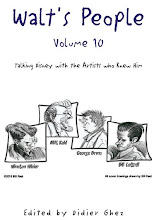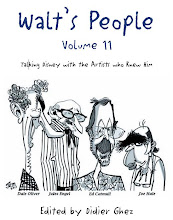 This unfortunately just in from Jeff Kurtti:
This unfortunately just in from Jeff Kurtti:[Eustace Lycett, 91, Designer of Special Effects for Disney Movies, Dies
Eustace Lycett, whose work helping to create special effects for major Disney productions — including characters in “Mary Poppins” who walk on smoke, and seemingly empty suits of medieval armor engaged in combat in “Bedknobs and Broomsticks” — earned him a share in two Academy Awards, died on Nov. 16 at his home in Fullerton, Calif. He was 91.
A spokesman for Walt Disney Studios, Howard Green, said yesterday that company officials had not been notified of his death until this week.
During a 43-year career with Disney, starting in 1937, Mr. Lycett worked on more than 30 films, including “Snow White and the Seven Dwarfs,” “Sleeping Beauty,” “Babes in Toyland,” “The Absent-Minded Professor,” “101 Dalmatians” and “20,000 Leagues Under the Sea.”
In 1964, along with Peter Ellenshaw and Hamilton Luske, he won an Oscar for special visual effects for “Mary Poppins.” And in 1971, with Alan Maley and Danny Lee, he won another Oscar in the same category for “Bedknobs and Broomsticks.”
Mr. Lycett was a protégé of Ub Iwerks, a pioneer of animation and special effects who for many years was head of the Disney studio’s process laboratory. They and other technicians worked together in the late 1930s to design a complex version of what was called the multiplane camera, a device that revolutionized animation by bringing depth to what had been a rather flat image. Mr. Iwerks, who died in 1971, had designed a simpler multiplane camera.
In a telephone interview yesterday, Mr. Iwerks’s son, Don Iwerks, a former chief of the Disney machine shop, explained that the camera separated a cartoon’s celluloid image into three planes: its background, an intermediate scene and the characters. “The fact that the planes could be moved independent of each other,” Mr. Iwerks said, “made it dimensional, in that objects in the foreground could move faster than the intermediate plane and then the background.”
The more sophisticated multiplane camera led to the production in 1937 of “Snow White,” the first full-length animated feature. Profits from “Snow White” allowed Walt Disney to build the company’s large studio complex in Burbank, Calif.
Eustace Arden Lycett was born in Straffordshire, England, on Dec. 21, 1914, the son of Martha Constance Walley and William Arden Lycett. As a mining engineer, Mr. Lycett’s father regularly moved with the family; they lived in Chile for years, and went to California in the early 1930s.
In 1937 Mr. Lycett earned a bachelor’s degree in mechanical engineering at the California Institute of Technology. That year, he also married Mary Ethel Goddard, who died in 2004. Mr. Lycett is survived by four sons: Kenneth, of Fullerton; William, of Placentia, Calif.; Roy, of Corona, Calif.; and Victor of Anaheim, Calif.; a sister, Nora Robertson of Carlsbad, N.M.; eight grandchildren; and 15 great-grandchildren.
It did not take Mr. Lycett long to find work. He graduated on a Friday and, based on an interview two weeks earlier, started work at Disney the following Monday. Mr. Lycett was named head of Disney’s special photographic effects department in 1958.
His career there was not limited to the big screen. He helped design “Great Moments With Mr. Lincoln,” one of the most popular exhibits at the 1964-65 World’s Fair in New York, and “Rocket to the Moon,” a major attraction at Disneyland.]






















1 comment:
Disney's artistic legacy was created by a vast number of talented people through the decades. Many have faded into anonymity. One such person was Eustace Lycett. While less known than some of his colleagues, his contributions to films like Mary Poppinsand Bedknobs and Broomsticks will be enjoyed forevermore. Thank you, Mr. Lycett. Rest in peace.
Post a Comment